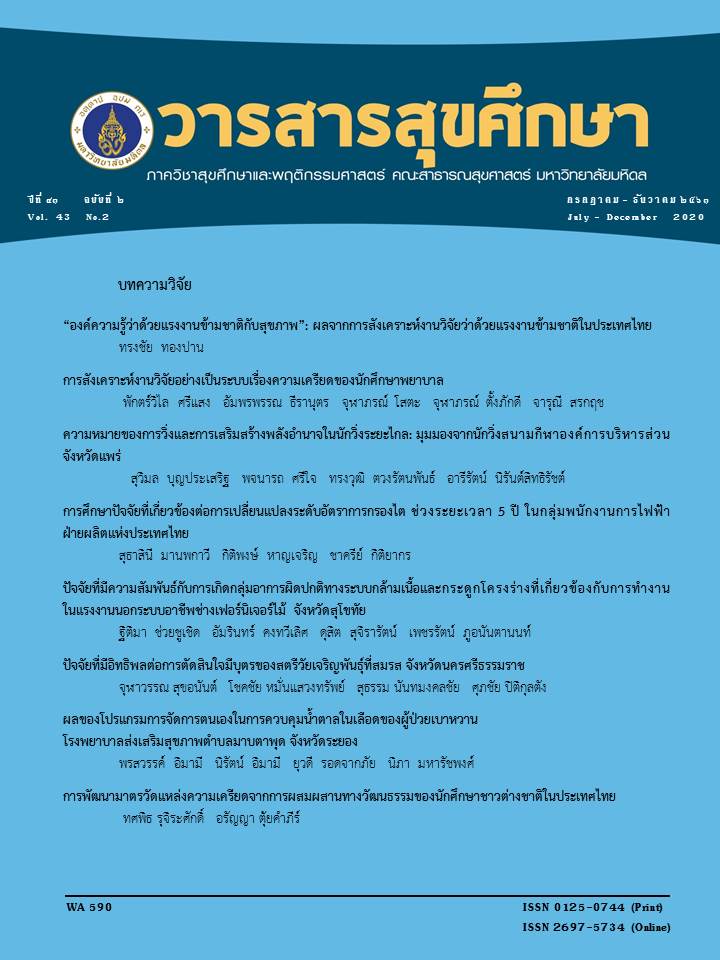Factors Influencing Childbearing Decision Making among Married Women of Reproductive Age in Nakhon Si Thammarat Province
Main Article Content
Abstract
Birth and fertility rates in Thailand tend to decrease. This cross-sectional survey research aimed to study the childbearing decision making and factors influencing childbearing decision making among married women of reproductive age in Nakhon Si Thammarat province. The sample population consisted of 282 married women of reproductive age, aged 20-34 years, selected by multi-stage random sampling. The data were collected by self-administered questionnaires from January 3rd to February 3rd 2019 and analyzed by frequency, percentage, mean, standard deviation and multiple logistic regression analysis. The study showed that the proportion of married women who decided to have children was 78.7%, and those who decided to have childless was 21.3%. Factors influencing childbearing decision making among married women of reproductive age with a statistical significance (p<0.05) were attitude towards having children, accessibility to childcare/ nursery service, and education level of women. Thus, public health service organization in Nakhon Si Thammarat Province should organize a campaign to promote the married women to have a positive attitude towards childbearing, especially those with a bachelor's degree or higher and provide the accessibility to standard childcare/nursery service.
Article Details
References
บุญเลิศ เลียวประไพ. ประชากรไทย อดีต-ปัจจุบัน-อนาคต. พิมพ์ครั้งที่ 1. นครปฐม: สถาบันวิจัยประชากรและสังคม มหาวิทยาลัยมหิดล; 2557.
สำนักงานสถิติแห่งชาติ. รายงานลักษณะของประชากร การสำรวจการเปลี่ยนแปลงของประชากร พ.ศ.2558-2559 [อินเทอร์เน็ต]. 2559 [เข้าถึงเมื่อ 19 มกราคม 2561]. เข้าถึงได้จาก: https://www.m-society.go.th/ewt_news.php?nid=18419.
กองบริหารงานวิจัยและประกันคุณภาพการศึกษา. พิมพ์เขียว Thailand 4.0 โมเดลขับเคลื่อนประเทศไทยสู่ความมั่งคั่ง มั่นคง และยั่งยืน [อินเทอร์เน็ต]. 2560 [เข้าถึงเมื่อ 19 มกราคม 2561]. เข้าถึงได้จาก: http://www.libarts.up.ac.th/v2/img/ Thailand-4.0.pdf.
สำนักอนามัยการเจริญพันธุ์ กรมอนามัย. นโยบายและยุทธศาสตร์การพัฒนางานอนามัยการเจริญพันธุ์แห่งชาติ ฉบับที่ 2 พ.ศ. 2560-2567 [อินเทอร์เน็ต]. 2559 [เข้าถึงเมื่อ 19 มกราคม 2561]. เข้าถึงได้จาก: http://rh.anamai.moph.go.th/download/all_file/brochure/layout%20นโยบาย
สำนักบริหารการทะเบียน กรมการปกครอง กระทรวงมหาดไทย. ตารางจำนวนประชากร การเกิด และการตาย ทั่วราชอาณาจักร ปี พ.ศ. 2536-2560 [อินเทอร์เน็ต]. 2561 [เข้าถึงเมื่อ 19 ตุลาคม 2561]. เข้าถึงได้จาก: http://social.nesdb.go.th/SocialStat/StatReport_Final.aspx?reportid=68&template=2R1C&yeartype=M&subcatid=1
ปวีณา ลีตระกูล, ชมพูนุท โกสลากร เพิ่มพูนวิวัฒน์. การวิเคราะห์บทบาทของผู้หญิงในตลาดแรงงาน. วารสารวิชาการเครือข่ายบัณฑิตศึกษามหาวิทยาลัยราชภัฏภาคเหนือ 2559;6(10):43-56.
ภูเบศร์ สมุทรจักร, นิพนธ์ ดาราวุฒิมาประกรณ์. ไลฟ์สไตล์ แผนการดำเนินชีวิตกับแนวคิดการมีบุตรของคนเจเนอเรชันวาย. ประชากรและสังคม 2557: การเกิดกับความมั่นคงในประชากรและสังคม 2557;213-31.
Myung Jin Lee, Myung Jin Hwang. Factors Contributing to Childbearing Intentions of Married Working Women in Korea. JPSS 2017;25:213-34.
Williams L, Abma J, Piccinino L. The Correspondence Between Intention to Avoid Childbearing and Subsequent Fertility: A Prospective Analysis. Fam Plann Perspect 1999;31(5):220-227.
Bühler C, Philipov D. Social Capital Related to Fertility: Theoretical Foundations and Empirical Evidence from Bulgaria. Vienna Yearbook of Population Research 2005;3:53-81.
Lampic C, Svanberg AS, Karlström P, Tydén T. Fertility awareness, intentions concerning childbearing, and attitudes towards parenthood among female and male academics. Hum Reprod 2006;21(2):558-564.
พิมลพรรณ อิศรภักดี. ทัศนคติของคนรุ่นใหม่เกี่ยวกับการแต่งงานและการมีบุตร. ประชากรและสังคม 2557: การเกิดกับความมั่นคงในประชากรและสังคม 2557;199-212.
เมทิณี แสงกระจ่าง. ความต้องการมีบุตรของสตรีไทยที่ทำงานในระบบ [ศิลปศาสตรดุษฎีบัณฑิต]. กรุงเทพมหานคร: จุฬาลงกรณ์มหาวิทยาลัย; 2558.
Moeeni M, Rashidian A, Aghajanian A. Women's relative status and childbearing intentions: Empirical evidence from Iran. PloS one 2018;13(4):1-10.
Thomson E. Couple childbearing desires, intentions, and births. Demography 1997;34(3):343-54.
จงจิตต์ ฤทธิรงค์, ธเนศ กิติศรีวรพันธุ์, วิมลทิพย์ มุกสิกพันธ์. สถานเลี้ยงเด็กช่วยให้คนมีบุตรมากขึ้น (จริงหรือ?). ประชากรและสังคม 2557: การเกิดกับความมั่นคงในประชากรและสังคม 2557;1:99-119.
วรเวศม์ สุวรรณระดา. ความคลอบคลุมของมาตรการสนับสนุนการเลี้ยงดูบุตรและผลกระทบต่อการตัดสินใจมีบุตรในประเทศไทย. กรุงเทพมหานคร: สำนักงานกองทุนสนับสนุนการวิจัย; 2548. RDG4710010. คณะเศรษฐศาสตร์ จุฬาลงกรณ์มหาวิทยาลัย.
Simon HA. Administrative Behavior. New York: The Mc Millen Company; 1960.
สำนักงานสถิติจังหวัดนครศรีธรรมราช. มองจังหวัดผ่านข้อมูลสถิต. รายงานสถิติจังหวัดนครศรีธรรมราช 2560 [อินเทอร์เน็ต]. 2560 [เข้าถึงเมื่อ 5 พฤศจิกายน 2560];1-2. เข้าถึงได้จาก:http://nksitham.nso.go.th/images/repo rt_pdf/statreport2560.pdf
สำนักงานสถิติจังหวัดนครศรีธรรมราช. จํานวนและอัตราเกิดมีชีพ การตาย ทารกตาย และมารดาตาย พ.ศ. 2555-2559. รายงานสถิติจังหวัดนครศรีธรรมราช 2560 [อินเทอร์เน็ต]. 2560 [เข้าถึงเมื่อ 5 พฤศจิกายน 2560]; 16. เข้าถึงได้จาก http://nksitham.nso. go.th/images/report_pdf/statreport2560.pdf
Daniel WW. Biostatistics: Basic concepts and methodology for the health sciences. Asia: John Wiley&Son; 2010.
Bloom BS. Taxonomy of education objective, Handbook Cognitive Domain. New York: David Mckay Company; 1975.
จุฑาทิพย์ ไพรวิจารณ์. ปัจจัยที่มีอิทธิพลต่อความสุขของหญิงตั้งครรภ์แรก ที่มารับบริการฝากครรภ์ ณ โรงพยาบาลส่งเสริมสุขภาพ สังกัดศูนย์อนามัยเขตภาคกลางของประเทศไทย [ปริญญาวิทยาศาสตรมหาบัณฑิต]. กรุงเทพมหานคร: มหาวิทยาลัยมหิดล; 2553.
กนกวรา พวงประยงค์. ความต้องการมีบุตรในอนาคต: หลักฐานเชิงประจักษ์จากสตรีที่สมรสในประเทศไทย. วารสารศรีนครินทรวิโรฒวิจัยและพัฒนา (สาขามนุษยศาสตร์และสังคมศาสตร์) 2561;10(19):1-19.
Kearney AL, White KM. Examining the psychosocial determinants of women's decisions to delay childbearing. Hum Reprod 2016;31(8):1776-87.
Kemkes A. Postponing or rejecting parenthood Results of a survey among female academic professionals. J Biosoc Sci 2003;35(2):213-26.


